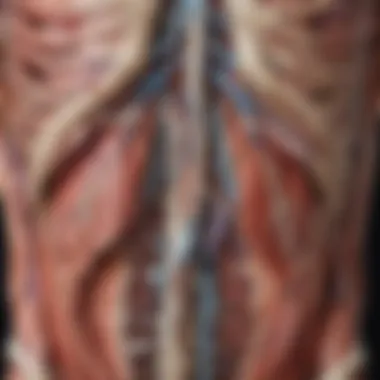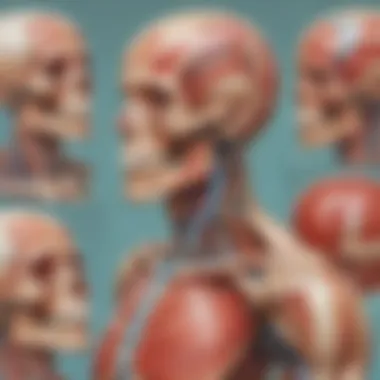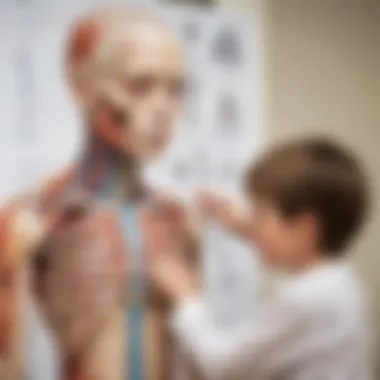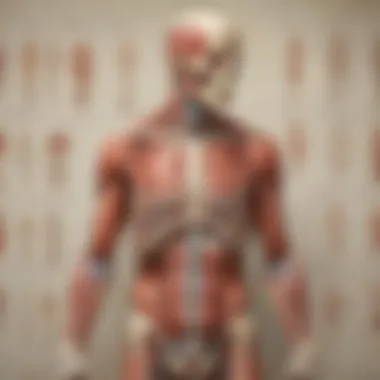Life-Sized Anatomy Posters: A Guide for Educators


Intro
Life-sized anatomy posters have carved out a unique niche in educational spaces. These large-scale visual aids not only bring the intricate human body to life, but they also capture the curiosity of children. This article aims to explore the various aspects of these fascinating educational tools, emphasizing their role in learning and fostering a deeper understanding of human biology.
By leveraging these posters, educators and parents can turn questions into discussions, making biology a vibrant subject, rather than a mere textbook concept. We will delve into how these tools can enhance learning experiences, from offering new visual perspectives to sparking conversations that might never have taken place otherwise.
This exploration will cover the dimensional aspects, educational benefits, and methods of selecting the right anatomy posters for children. Whether you are a teacher, a parent, or a caregiver, this guide is tailored to enrich your approach to children's education and ignite their natural curiosity about the human body.
Understanding Life-Sized Anatomy Posters
Life-sized anatomy posters are not just oversized images; they serve as valuable resources in the educational landscape. These posters provide a visual representation of human and animal anatomy, allowing learners to grasp complex biological systems in a more interactive and tangible way. By engaging with these large-scale, detailed illustrations, children can develop a clearer understanding of bodily structures and functions.
The use of life-sized anatomy posters fosters an immersive learning experience. They bridge the gap between theoretical knowledge and practical understanding, catering especially to visual learners. When kids see an actual scale of the human skeleton, for instance, they can better appreciate the size and placement of bones compared to their own bodies.
Another benefit is the posters' ability to spark curiosity. Children often have questions about how their bodies work or why certain organs look the way they do. Life-sized anatomy posters can act as conversation starters. Parents, educators, and caregivers can use them to facilitate discussions about health, biology, and the importance of bodily functions, making learning more dynamic and engaging.
In short, the significance of understanding life-sized anatomy posters lies in their multi-faceted role in education: as tools for visual learning, platforms for discussion, and enhancers of student interest in science.
Definition and Purpose
Life-sized anatomy posters are detailed visual aids that depict anatomical structures at a scale that reflects their actual size. The primary purpose of these posters is educational; they are designed to enhance the learning experience by providing a clear, comprehensive view of anatomy. For example, when a young learner examines a detailed poster of the human heart, they can identify different parts—such as the atria and ventricles—and can learn about how blood circulates through the body.
Additionally, these posters are used in various settings, including classrooms, homes, and healthcare facilities. They serve not only as educational tools for children but also as reference materials for professionals, thus highlighting their versatility.
Historical Context
The idea of using visual aids for education dates back centuries. However, the specific use of life-sized anatomy posters took root during the 20th century, driven by advances in printing technology and a growing emphasis on visual learning styles. The posters began to gain traction in medical schools and universities, where students benefited from a chance to study anatomy in scale rather than solely in textbooks.
As educators and parents sought more effective teaching methods, these posters were adapted and made accessible for younger audiences. Over time, the printing capabilities evolved, allowing for more intricate designs that are not only educational but also visually appealing. Today, anatomy posters are available in various themes, including human anatomy, animal anatomy, and even comparative anatomy, further broadening their educational scope.
"The evolution of educational tools has paved the way for life-sized anatomy posters to become integral to effective learning strategies in modern education."
This historical trajectory reflects a growing recognition of the importance of visual methods in education, underscoring why anatomy posters continue to play a significant role in teaching anatomy to children.
Anatomical Dimensions and Scale
Understanding the anatomical dimensions and scale of life-sized anatomy posters is pivotal for their effective utilization in education. These posters serve not just as decorative pieces but as integral tools in teaching and understanding human biology. When educators and parents grasp the significance of these dimensions and the accurate representation of scale, they can better support children's learning processes.
Importance of Scale Accuracy
The accuracy in scale is fundamental when it comes to life-sized anatomy posters. A poster that accurately reflects the size and proportions of human anatomy ensures that students can develop a tactile understanding of their own bodies. For instance, if a heart is displayed inaccurately—too large or too small—students might cultivate misconceptions about how it functions in the body.
In an educational context, here’s why scale accuracy matters:
- Realistic Representation: Students get to see how different organs relate to each other in terms of size. This holistic view bridges knowledge gaps.
- Effective Comparison: When learning about various systems—like respiratory or circulatory—accurately scaled posters allow better comparisons between organs, aiding recall and comprehension.
- Enhanced Memorization: Not only does it make learning more engaging, but accurately represented dimensions can also boost memory retention. The brain loves patterns and will remember things better when they correspond to what is realistic.
"Anatomical accuracy in education is akin to having a compass when exploring uncharted waters; it guides learners through the intricacies of human biology successfully."
Interpreting Size in Learning
Interpreting size in the context of anatomy posters goes beyond just recognizing dimensions. It’s about understanding the contextual relevance of these sizes in daily life. For children, relating the size of their own body parts to these massive visual aids makes a significant impact.
Several factors play a role in how children interpret size:
- Visual Size Contrast: Large images can make body parts look bigger than they are. This can spark discussions about proportion and function. For instance, examining a life-sized foot can lead to conversations about balance and mobility.
- Empathy and Connection: By seeing how big the heart, lungs, or brain actually are compared to their own bodies, children develop a deeper sense of empathy towards human experiences and health.
- Hands-On Learning: Engaging students with interactive sessions while referencing anatomy posters encourages them to explore size through movement. For example, they can compare their heights to the height of a life-size figure, prompting physical enactments of concepts learned visually.
Artistic Representation in Anatomy Posters
Artistic representation in anatomy posters plays a crucial role in how these educational tools convey complex biological concepts to children. The visual depiction of anatomical structures not only enhances comprehension but also sparks curiosity about the human body. In an age where digital devices dominate, a well-crafted poster can offer a tangible and vibrant alternative that draws attention and fosters engagement.


Illustration Techniques
When it comes to illustrating anatomy, the technique employed significantly influences the effectiveness of the learning experience. Traditional hand-drawn illustrations often come with a personal touch that can feel more approachable, especially for younger audiences. These illustrations can embody artistic flair while maintaining scientific accuracy. On the other hand, digital illustrations are becoming increasingly popular due to their versatility and ability to be easily modified. Here are some specific techniques that are vital:
- Cross-Sectional Views: This technique allows students to view layers of the body organs, creating an understanding of how they interact.
- 3D Renderings: These can make concepts such as spatial relationships in the body clearer and more relatable.
- Realistic vs. Stylized Representations: While realistic images are important for serious study, stylized versions can make learning fun and less intimidating for children. Sometimes, a more cartoonish style can help maintain interest and facilitate learning.
Incorporating different illustration techniques ensures that anatomy posters can cater to a range of learning styles, enhancing educational value for children.
Color Usage and Labeling
Color is not merely a tool for aesthetics; it serves an educational purpose as well. The right palette can enhance memory retention and recognition of anatomical features. For instance, using bold colors to highlight critical parts such as the heart or brain can help children focus on essential information. Thoughtful use of colors can also aid in distinguishing between different systems in the body, like the circulatory and respiratory systems.
Labeling each part clearly and logically is equally important. Labels should be:
- Readable: Ensure that fonts are large enough to be seen from a distance.
- Consistent: Use similar styles and font sizes to create a cohesive look.
- Informative: Each label can include brief descriptions, which provide context and encourage deeper learning.
Children often learn through visual association, so the combination of color and careful labeling can enhance their ability to recall what they’ve learned. This combination allows for a more holistic approach to learning anatomy.
"Artistic choices in anatomy posters can transform educational content into a visual narrative that resonates with young learners and ignites their curiosity about the human body."
By thoughtfully combining illustration techniques with strategic color usage and labeling, educators can create anatomy posters that serve as effective educational tools. This not only enriches the learning experience but also fosters a deeper understanding of human biology among children.
Educational Applications of Anatomy Posters
Educators and parents alike recognize the potential of life-sized anatomy posters as more than just decorative pieces on a wall. These posters serve myriad educational purposes, empowering the understanding of complex biological systems. Their size and detail can transform a simple classroom or home space into a dynamic learning environment. In this section, we will explore specific teaching techniques, how these posters support curriculum standards, and their role as tools for assessment and review.
Teaching Techniques
When it comes to teaching, anatomy posters provide a visual foundation that can greatly enhance traditional methods. For instance, educators can employ the collaborative learning technique where students gather around a poster to discuss anatomical structures. This approach not only engages learners but also fosters peer-to-peer interaction, leading to a deeper understanding.
Using anatomy posters, teachers can apply visual storytelling techniques. By presenting a narrative around the human body—like how the circulatory system works during a marathon—students can better grasp the interconnectedness of systems. This makes the content relatable, rather than just an isolated topic in a textbook. Moreover, some educators integrate hands-on activities, where students trace or sketch structures directly modeled on the posters, reinforcing muscle memory alongside visual learning.
Supporting Curriculum Standards
Life-sized anatomy posters have a significant role in supporting curriculum standards. They are particularly valuable for aligning with Next Generation Science Standards (NGSS), which emphasize understanding systems and their functions. Posters can be utilized to meet objectives related to life sciences, allowing students to visualize what they learn in context. Educators can design lesson plans that integrate these posters, aligning activities and discussions directly with specific learning outcomes set by educational authorities.
Furthermore, using these visuals addresses different learning styles—be it visual, auditory, or kinesthetic—making lessons inclusive. They act as a bridge for learners who might struggle with textual information, turning abstract concepts into tangible discussions. In essence, anatomy posters become a canvas upon which educators can paint entire units of study.
Assessment and Review Tools
Anatomy posters can also play a pivotal role in assessment and review. They provide a practical way to gauge student understanding. Teachers can use them for formative assessments; for example, one could ask students to identify and label various body parts in a quiz format or during a group activity. This active engagement can assist in measuring both retention and comprehension.
Moreover, these posters can be instrumental in creating review stations where anatomy is gamified. Students may rotate between various posters and complete different tasks related to those images, such as solving puzzles or answering questions based on what they see. This interactive approach helps in reinforcing previously covered material while making learning enjoyable.
"Visual aids like anatomy posters are not just decorations; they are powerful tools that can bring complex ideas to life!"
In summary, life-sized anatomy posters are not just static visuals. Their applications in education extend far beyond mere display, fostering techniques that enhance understanding, supporting curriculum goals, and serving as effective assessment tools all at once. Integrating these posters into educational environments opens doors to richer learning experiences for children.
Promoting Curiosity Through Visual Learning
Curiosity serves as the ignition for the fires of learning, especially in children. Life-sized anatomy posters play a pivotal role in stirring this curiosity, providing visual stimuli that can transform passive observing into active exploration. This section examines how these educational tools engage young minds, making anatomy not just a subject to study but a fascinating world to uncover.
Children's Interest in Anatomy
Children are natural explorers. Their eagerness to understand the world around them is unmatched. Life-sized anatomy posters cater to this instinct in several ways.
Often, a simple image of the human skeleton or a detailed representation of the muscular system can spark a flurry of questions. Why do we have bones? How do muscles help us move? Engaging visuals can ignite even the most reluctant learners, transitioning anatomy from a dry textbook chapter to a vivid storytelling experience.
To further capture their interests, it often helps to tie the visuals into real-life applications. For instance, discussing how the heart works while looking at a poster showing the organ's size and location can deepen their understanding. Studies have shown that visual learning can enhance memory retention. Those vibrant colors and life-like details stick in a kid's mind much longer than mere text.
Research, like that found on Britannica, supports the idea that when children engage with educational tools that pique their curiosity, they are more likely to delve into subjects with enthusiasm.
Facilitation of Discussion Topics
When placed in a common area, life-sized anatomy posters become conversation starters. They offer a shared reference point for parents, educators, and children alike. Imagine a group of kids pointing at the large poster of the human body with questions bubbling up. "Why does the brain have so many wrinkles?" or "How do our lungs function?" These discussions can develop organically, fostering a deeper comprehension of anatomy while making learning enjoyable.


Additionally, posters can provide a framework for structured discussions. For instance, if a class is studying the circulatory system, referencing the life-sized heart poster can lead to worthwhile debates about health, exercise, and nutrition. Facilitating such discussions not only feeds curiosity but also engenders critical thinking—a skill crucial for any learner.
Curiosity isn't just about answers; it's about the questions that lead us there.
Thus, integrating life-sized anatomy posters into learning environments does so much more than paint a pretty picture. This approach helps children connect the dots between their curiosity and the vast world of human anatomy, opening opportunities for impactful learning every moment they engage with these visuals.
Choosing the Right Anatomy Poster
Selecting the right anatomy poster is crucial when it comes to educating children about human biology and anatomy. The correct choice can make an enormous difference in engagement and understanding. Life-sized anatomy posters present complex information in a way that can be visually grasped and easier to comprehend. This guide dives into several vital factors to consider and types of posters available, ensuring that clarity and educational value are at the forefront.
Factors to Consider
When choosing an anatomy poster, several key factors can influence your decision:
- Age Appropriateness: The content of the anatomy poster should match the age of the children. Younger kids benefit from colorful, simplified images, while older students may prefer detailed illustrations.
- Specific Focus: Determine the area of anatomy to be studied. For instance, is the focus on the skeletal system, muscular system, or internal organs? Having a clear topic in mind ensures the poster serves its purpose efficiently.
- Quality of Illustration: The visual appeal of a poster matters. High-quality illustrations that are accurate and vibrant draw children’s attention, making the learning experience enjoyable.
- Labeling and Information: Ensure that the poster has comprehensive labeling and accompanying explanations. This can enhance understanding and retention of the material.
- Durability: Consider the material of the poster. Plastic or laminated options may last longer, especially in a school setting where wear and tear is common.
Types of Anatomy Posters Available
When it comes to anatomy posters, various types cater to different educational needs. Understanding the distinctions among them can help educators, parents, and caregivers make informed choices:
Human Anatomy
Human anatomy posters are perhaps the most popular choice among educators. They provide detailed representations of the human body, often highlighting systems like the circulatory, digestive, and nervous systems. The key characteristic of these posters is their ability to depict intricate details, making them beneficial learning tools.
- Unique Feature: Many human anatomy posters are labeled with both common names and scientific terminology, catering to a range of educational levels. This allows for a structured learning approach that can be progressively advanced.
- Advantages: These posters engender a deeper understanding of human biology and can be pivotal for students pursuing further scientific education.
- Disadvantages: Some human anatomy posters may overwhelm young children due to their complexity or amount of detail, which could lead to confusion rather than clarity.
Animal Anatomy
Animal anatomy posters serve to educate children about various species and their biological structures. These posters can include domestic animals, wild animals, or even marine life, making them a fascinating study subject.
- Key Characteristic: They often compare structures across different species, fostering an appreciation for biodiversity.
- Advantages: These posters can ignite curiosity about zoology or veterinary science, encouraging kids to explore these fields. Learning about animal anatomy can also aid in understanding human anatomy through comparative study.
- Disadvantages: However, animal anatomy can sometimes feel distant for kids more interested in human biology, which might lead to less engagement.
Comparative Anatomy
Comparative anatomy posters take learning a step further by illustrating the anatomical similarities and differences among species. They provide context for how evolution shapes organisms based on their environments.
- Key Characteristic: A standout element is that they often include illustrations of both human organs and corresponding animal organs, showcasing evolutionary adaptations.
- Advantages: These posters help foster critical thinking and can enrich discussions about biology, evolution, and ecology among children.
- Disadvantages: The complexity of comparative anatomy can be a barrier for younger learners, possibly requiring supplementary explanations to aid understanding.
Ultimately, choosing the right anatomy poster hinges on aligning educational goals with the needs and interests of children, making the learning experience both informative and enjoyable.
Displaying Anatomy Posters Effectively
Displaying anatomy posters in a thoughtful manner is key to enhancing their educational value. When these posters are presented with care, they transform mere wall decorations into vibrant learning tools. People easily underestimate the power of visual aids; however, how they are displayed can significantly affect engagement and retention. Thus, the focus on visibility and involvement is paramount.
Best Practices for Visibility
Visibility is one of the foundational aspects of using anatomy posters effectively. If a poster is difficult to see, it loses its persuasive power. Here are some best practices that you can utilize:
- Location: Place the poster in a position where learners will naturally stop to take a look. Near working areas or common gathering spots is often ideal.
- Lighting: Ensure that the area is well-lit. Shadows can obscure important details, making it harder for children to appreciate what they’re viewing. Consider using overhead lights or repositioning the poster if you notice problematic shadows.
- Distance: The height and distance from which viewers will most commonly observe the poster should be considered. Young children, for example, may need materials placed lower to the ground.
"Proper visibility isn’t just about making something ‘seeable.’ It’s about ensuring that it catches the eye and invites inquiry."
With these practices, a poster can become a point of fascination rather than just another item on the wall.
Creating an Engaging Learning Environment
An engaging environment can ignite curiosity and inspire interaction with anatomy posters. Here are several strategies to consider:
- Discussion Corners: Set up a cozy area nearby with seating where children can sit and discuss what they see. This not only encourages conversation but also allows them to express what they have learned, reinforcing the material.
- Hands-On Activities: Incorporate tactile experiences by providing models or diagrams that children can manipulate alongside the posters. This dual approach of visual and tactile learning strategies can significantly enhance retention and understanding.
- Rotating Displays: Change out the posters periodically to keep the content fresh and related to current learning themes. A child might already be aware of the human skeletal system through a previous unit, but adding a heart anatomy poster can rejuvenate their interest and prompt more questions.
- Interactive Elements: Consider adding overlays or augmented reality components. Simple QR codes linked to videos explaining the anatomy or allowing for virtual exploration can create a richer learning experience.
These strategies contribute to an atmosphere where learning flourishes. Visualization isn’t merely passive; it is an active engagement that deepens understanding.


By thoughtfully displaying life-sized anatomy posters, both visibility and educational interaction can be maximized, ensuring that learners retain critical information while simultaneously fostering a lifelong fascination with human biology. The key takeaway here is that any poster can become a powerful teaching tool if it’s positioned and presented correctly.
Integration into Different Learning Environments
Life-sized anatomy posters can play a significant role in various educational environments, enriching the learning process for children. By integrating these visual tools into different settings, educators and caregivers can leverage their benefits to enhance engagement, comprehension, and retention of knowledge. This section will explore how anatomy posters can be effectively implemented in classrooms and at home to support children's learning experiences.
Classroom Settings
In a classroom environment, the presence of life-sized anatomy posters fosters a dynamic and interactive learning atmosphere. When students are exposed to vibrant, large-scale representations of anatomical structures, it cultivates a sense of curiosity and encourages hands-on learning. Here are a few ways these posters can be utilized effectively:
- Visual Anchor: Posters serve as a visual reference for students, making complex concepts more accessible. Teachers can direct students' attention to specific anatomical details during lessons, solidifying understanding through visualization.
- Discussion Starters: Anatomy posters can stimulate lively discussions among students, helping them articulate their thoughts, ask questions, and learn from one another. This interaction enriches the learning experience and encourages critical thinking.
- Interactive Activities: Teachers can create engaging activities, such as scavenger hunts or labeling exercises, where students work in groups to identify various anatomical parts. This kind of collaboration fosters teamwork and enhances motivation.
Moreover, effective placement of these posters in high-traffic areas or digital formats in virtual classrooms can ensure that anatomical knowledge is consistently reinforced. This accessibility can enhance students' overall educational experience.
At Home Learning
When it comes to at-home education, life-sized anatomy posters can be powerful tools for parents and caregivers. Using these resources at home presents unique opportunities for children to explore anatomy at their own pace. Here are ways in which these posters can be integrated:
- Supplementing Curriculum: Parents can use anatomy posters to reinforce learning that takes place in school. By discussing and reviewing these visuals at home, children can build upon what they learned in class, making connections and enhancing their understanding.
- Encouraging Exploration: Children can express their natural curiosity about the human body by exploring the details of anatomy posters. Parents can facilitate this exploration by asking open-ended questions, prompting discussions about body functions, and connecting these concepts to everyday life.
- Family Learning Activities: Engaging the whole family can transform education into a fun group activity. Parents can organize activities where everyone participates in learning, like a quiz night based on anatomical knowledge. This shared experience can help siblings bond while enriching their understanding of biology.
The key to maximizing the benefits of life-sized anatomy posters in both classroom and home settings lies in their interactive usage, enabling children to engage with the material actively and thoughtfully.
Ultimately, whether in classrooms or at home, the goal remains the same: to encourage children to explore, learn, and develop a deeper appreciation for the intricacies of the human body. Leveraging life-sized anatomy posters in these different environments can transform education into an engaging, hands-on experience, setting the stage for a lifelong pursuit of knowledge.
Feedback and Evaluation
In any educational setting, feedback acts as a compass guiding both teachers and students towards improvement. In the context of life-sized anatomy posters, this feedback serves numerous pivotal roles in sharpening understanding and enhancing the overall effectiveness of educational methodologies. Emphasizing the dual nature of feedback—both as a tool for assessment and as a means to encourage further exploration—can significantly boost the educational impact of these visual resources.
Assessing Student Understanding
To gauge how well students grasp the information presented on anatomy posters, teachers can employ various assessment strategies. These include quizzes that focus on anatomical labels or collaborative group discussions where students articulate their understanding of various body systems. For instance, a teacher might display a life-sized human anatomy poster and prompt students to outline the functions of each organ. This technique not only assesses knowledge but also encourages critical thinking.
Other effective methods include:
- Interactive Activities: Have students create flashcards based on the anatomy poster, with visuals on one side and descriptions on the other.
- Peer Teaching: Students can pair up and teach each other about specific body parts, which reinforces their own understanding.
- Reflective Journals: Encouraging children to write about what they learned from the posters provides personal insight into their comprehension.
"Feedback is a gift that allows the growth of knowledge and understanding," emphasizing the importance of open communication in education.
These strategies help in pinpointing areas where students excel and where they might need a little more support. This targeted feedback not only helps in reinforcing accurate knowledge but also fosters a growth mindset, encouraging students to embrace challenges in learning.
Iterative Improvements
Feedback leads to iterative improvements, a crucial aspect of the teaching and learning cycle. After evaluating student understanding, it's essential to reflect on both the effectiveness of the anatomy posters themselves and the methods used to present information.
Educators can consider:
- Poster Design: Is the information clear and visually engaging? If students struggle to recall information, perhaps the poster's layout needs refreshing.
- Presentation Style: What teaching methods resonate best with students? An analysis of engagement levels can guide educators to switch techniques or incorporate multimedia elements.
- Content Consideration: Does the poster cover the necessary aspects of anatomy? Teachers can adjust the content based on feedback to ensure comprehensiveness.
By continually refining the resources and methods used, the learning experience becomes increasingly effective and tailored to meet the needs of students. In this way, feedback isn't just a one-off occurrence; it transforms into a dynamic process that ensures educational tools, like life-sized anatomy posters, remain relevant and impactful. This ongoing evolution is fundamental in fostering a classroom environment where curiosity thrives and foundational knowledge of anatomy flourishes.
End: The Value of Life-Sized Anatomy Posters
Life-sized anatomy posters hold a noteworthy place in education, providing not just information but an enhanced learning experience. As tools that go beyond mere decoration, they play a fundamental role in bridging gaps between theoretical knowledge and practical understanding. For children, especially, these posters can spark an interest in biology that lasts a lifetime. They witness their own body’s complexity reflected in an engaging format, making it easier to grasp anatomical concepts that could otherwise seem distant or purely academic.
Anatomy posters enable children to see and understand their bodies in ways that typical textbook descriptions cannot.
Encouraging Lifelong Learning
The journey of learning doesn’t stop at childhood, and anatomy posters can be your partner in promoting lifelong educational pursuits. When children are first exposed to the intricate workings of the human body through these vibrant and detailed representations, it’s not just a matter of memorizing bones or organs. It plants the seed of curiosity. They'll start to ask questions—why does my heart beat? How do my muscles work?
As those questions emerge, they can lead to deeper explorations in biology, health sciences, or medicine later in life. This ongoing quest for knowledge forms a robust foundation for critical thinking and inquiry, skills that transcend any classroom. The visual aspect of these posters makes the learning process engaging, ensuring that kids find joy in discovery.
Final Thoughts on Educational Impact
The impact of life-sized anatomy posters extends far beyond the classroom walls. In homes where learning is embraced and curiosity is encouraged, these posters become allies. They make discussions about health, fitness, and biology more approachable for families. Parents can use them as tools to explain everything from nutrition to exercise, creating a comprehensive learning environment.
In summary, the educational value of life-sized anatomy posters is undeniable. They serve as more than just visual aids; they are catalysts for curiosity, understanding, and discussion. The choice to include these posters in educational settings can lead to a more enriching and engaging curriculum, fostering not only knowledge about anatomy but a broader appreciation for the complexities of living systems. By effectively leveraging anatomy posters, caregivers, educators, and children themselves can together unlock a wealth of possibilities for learning and exploration.















